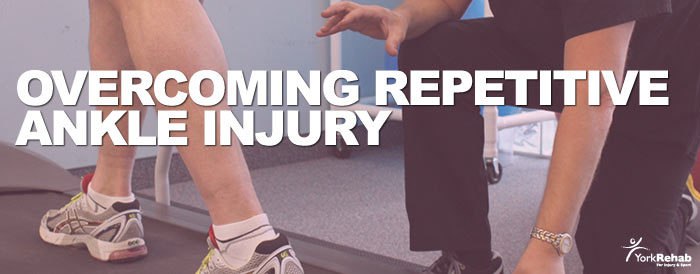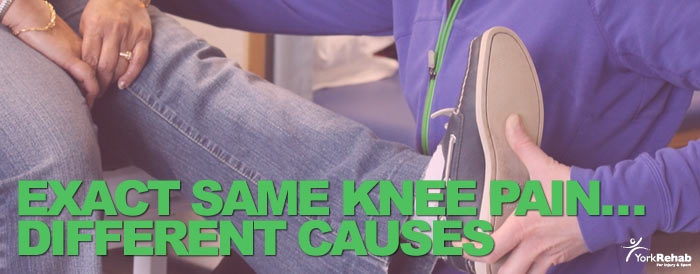Overcoming Repetitive Ankle Injuries
A common injury for people involved in sports such as soccer, tennis, squash, or running is an ankle sprain. Many athletes and weekend warriors alike have experienced this injury, often multiple times, and may rely on using a brace for support to prevent re-injury or be forced to cut back on their participation due to recurring injury. It is possible to minimize the recurrence rate of this injury by seeing a qualified physiotherapist who can assess for and address the following limitations that are common in people with repetitive ankle injuries.
Some people who have had a long history of ankle injury have range of motion limitations. What can happen is the ankle swells following the sprain, and it gradually recovers, but the scar tissue that forms to rebuild the injured tissue does not get adequately stretched. This is how a stiff ankle can develop, and playing sports with this movement loss can lead to another injury quickly. A physiotherapist can identify these limitations and prescribe the proper stretches to recover as much mobility as possible.
Secondly, following the recovery from an acute (within 6 weeks of injury) ankle sprain there might not be any residual pain, but often there is a lingering weakness. Because the ankle feels free of pain the athlete is compelled to return to their sport, neglecting the strength deficits that are present. Depending on the sport, this might manifest as decreased endurance, overall strength, or explosive power such as in jumping sports. This can be remedied by regularly performing the appropriate exercises specific to your sport, exercises which can be determined by a physiotherapist.
A hidden impairment that an athlete may not notice after an ankle injury is decreased proprioception. This refers to the “position sense” of your joints and ligaments, similar in a way to other senses such as vision and smell. There are sensors embedded in these tissues that give the body feedback about where it is in physical space, and we rely on this sense to maintain good balance and stability during weight-bearing activity. After an ankle sprain, we often lose some of this sense, but it can be readily retrained much like muscle strength can. Specific balance exercises can be done to regain this sense, with progressions to sport-specific activity.
Building on that last point, before returning to your activity is considered, an athlete should be able to perform the necessary tasks involved in the activity. For example, a soccer player should be able to sprint, change directions quickly, kick, and dribble a ball. Often the speed at which these activities can be done following an ankle injury is much less than in normal conditions. Agility exercises and plyometrics, which are a type of exercise involving explosive movements such as jumps and sprints, are essential here. Regaining these skills is crucial to minimize the risk of long-term ankle injury recurrences.
To summarize, if you have had trouble with repetitive ankle injuries, you should consider seeing a physiotherapist who will assess to see if any impairments discussed above are present and design the optimal program for you to address them. Frequently the solution to the problem is relatively simple; it just takes some diligence to stick with the program to see results. Instead of worrying about your ankle every time you return to activity, wouldn’t it be nice to pivot, jump, sprint or whatever you do with confidence? You can make that a reality following an individualized physiotherapy regimen to help with your recovery, so you can get you back in the game as quickly and safely as possible.
Is Chronic Pain something you live with forever? The Answer may surprise you.
Do you have a bum shoulder? A bad knee? Do you have a pain from an injury that has persisted for months or years? You may have talked to friends or co-workers about it and likely heard “Oh that’s chronic pain and it’s something you just live with” or “Well, what do you expect, you’re getting older”. Many people who develop such pains assume that because their injury was a long time ago, their pain is set in stone and there’s nothing you can do about it. Or, as you get older, it will be more difficult to get rid of it. Well, there is hope! These long-lasting pains don’t have to stay around forever; there are several courses of recovery that can take place depending on the nature of the original injury and the natural repair process that has taken place since.
In scenario 1, let’s assume you have pain from an old shoulder injury. It got better initially but just didn’t seem to fully heal, and now you’re left with some lingering pain. Normally what happens during the first few weeks of soft tissue healing (for example with muscle or ligament) is your body deposits scar tissue to rebuild the injured site. If we looked at the tissue fibres under a microscope at this point we would find them disorganized and unlike the original tissue where the fibres are lined up in parallel. If controlled stress (stretching and/or strengthening) is applied to the injured site at this stage, it would begin to remodel and look more like the original tissue. Depending on the severity of the original injury and assuming no other complications, after several more weeks of recovery and exercise the injured site can become pain-free and function well.
However, some people mistakenly believe that a tissue will heal fully on its own with time, or initially they misinterpret the pain that occurs with stressing the injured site and avoid it. In both cases, the remodelling process is not undertaken, and the scar tissue remains disorganized and tight, causing pain every time it is stressed. The good news is if you understand what is happening and are guided through the remodelling process with the assistance of a physiotherapist, you can make changes to this tissue and achieve a gradual recovery over several weeks or months. Typically this will involve an individualized and structured home exercise program – which can involve strengthening and stretching.
In scenario 2, let’s say you find yourself with pain from an old knee injury and no matter how much you try to remodel it following the principles above, the pain doesn’t go away. Sometimes what can happen at the time of injury is the resting position of the joint is disturbed so now it isn’t “hinging” properly anymore. Again, the positive here is this situation can be reversed quickly with the help of a physiotherapist who can identify the right movements to return it to its proper position. It’s like a floor rug being ruffled up in front of a door – when you try to open the door, it gets blocked by the rug. So what you have to do is find the right way to move the rug and then the door will open smoothly again. There are cases where pain that has persisted for years can respond to simple movements rapidly due to this problem.
The bottom line is this: just because you have had pain for months or years from an old injury that seems to be unchanging, it doesn’t mean you’re doomed to live with it. There’s hope! You can simply start by making an appointment with a physiotherapist. They’ll listen to you and do a thorough assessment to determine the nature of the problem, and design a recovery plan for you. Remember, you don’t need a doctor’s referral to book an appointment with a physiotherapist. As long as you’re willing to put in the effort to recover, the results will likely follow. Wouldn’t it be nice to leave behind that nagging pain you thought would be with you for the rest of your life?
Exact Same Knee Pain…Different Causes
When you’re told you need to go see a physiotherapist, what do you think of? You may think of stretching, strengthening, heat/ice, ultrasound, endurance training, balance exercises, or electrical stimulation. All these thoughts fall under the category of treatment. What you may not consider is your physiotherapist as a diagnostician. Therapists who are trained in Mechanical Diagnosis & Therapy, also known as the McKenzie Method, are diagnosticians first and foremost. The three cases presented below illustrate this point – all three patients came in with pain in the front of their knees, but the underlying reason for each pain was different and demanded unique management strategies.
The first patient was a 14-year-old female who had right knee pain episodically for the past 2 years – at the time of assessment she had it for 1 month. It was painful when bending, standing, squatting, lunging, and sometimes when sitting, walking, and negotiating stairs, and prevented her from participating in karate. The history and physical exam indicated it could be a typical knee problem, but in the McKenzie Method the lumbar spine (lower back) is first assessed for any contribution – spinal conditions can refer in unusual ways to the extremity. Ultimately it was found that repetitive lumbar extension brought about relief from her knee pain, which she was easily able to do at home, and after some reconditioning exercises, she made a full return to karate.
The second patient was a 60-year-old male who had pain in both knees for a year after a day of heavy ladder use at work. The pain was there mostly when getting out of a chair and walking the first few steps, and also sometimes with squatting. As with the patient above, his lower back was assessed for any contribution and was ruled out because of no change to his presentation. His knees were then assessed with repetitive movement testing. Repetitive straightening (hyperextension) caused a significant reduction in his squatting pain. Within a week of performing this exercise 4-5 times per day, he was 90% free of pain with full movement and strength.
The third patient was a 39-year-old male who had right knee pain intermittently for 2 years after doing some moving; going up and down stairs and squatting were his two most painful activities. As above, his lumbar spine was assessed first, which had no effect on his presentation, so it was ruled out. Repeated knee movements also had no lasting effect but it was found that repetitive straightening of his knee with an ankle weight consistently produced his pain. This pain did not remain afterward. This presentation is consistent with a dysfunction or suboptimal healing of the patellar tendon. Consistent remodeling of his tendon via progressive resistance exercises over two months proved to steadily diminish his pain. He was able to go up and down stairs without pain at that point and had made a return to biking.
The three cases outlined above all had frontal knee pain, but for different reasons: one was due to a lower back joint problem, one was due to a knee joint problem, and the last was the result of a patellar tendon dysfunction. These diagnoses were sorted out following the principles of the McKenzie Method and each patient was given an effective self-management strategy that led to resolution of the problem. Make sure the next time you need to see a physiotherapist that you are given a good mechanical assessment that focuses on understanding the cause of your problem, and not just what can be done to treat the symptoms.
Our Newmarket Physiotherapy clinic has several physiotherapists trained as McKenzie Method practitioners. Our physio clinic also has 2 of only a handful of therapists in Canada who have completed the Diploma Program in Mechanical Diagnosis and Therapy (MDT) and the most number of credentialed therapists in an Ontario clinic.
Hidden Calories in Holiday Drinks
People concerned about calories often try to limit the intake of sweets over the holidays but may overlook another significant source of calories… alcoholic drinks! The number of calories in mixed drinks can add up quickly and could easily contribute to an expanding waistline during the holidays.
Indulging in an alcoholic beverage doesn’t have to derail your fitness efforts if you keep calories low and make wise choices. Learn how many calories are in four popular drinks and some options to reduce their calories:
Piña Colada
This tropical island treat is made with light rum, coconut milk, and pineapple juice. While the tropical taste may help ward off the winter blahs, you may end up singing the blues once you learn a 12-ounce drink has about 590 calories.
Lighter Option: Mix 1-ounce coconut rum with 4-ounces of pineapple juice over ice, top with club soda. By skipping the high fat and high-calorie coconut milk, you can reduce the calories by 75%.
Mudslide
Flavours of chocolate and coffee come together in this drink made with coffee-flavored liqueur, Irish cream, vodka, chocolate syrup and half-and-half cream. Due to the rich and creamy ingredients, a 6-ounce drink comes in at 560 calories.
Lighter Option: Skip the high-fat cream, ditch the chocolate syrup and Irish cream in favour of coffee liqueur, chocolate vodka mixed with low-fat milk.
Brandied Eggnog
For some, there is nothing more festive than sipping on spiked eggnog at a holiday gathering. The list of ingredients may be short – brandy combined with store bought eggnog – but the calorie count is high at over 400 calories per cup.
Lighter Option: Mix low-fat eggnog with cinnamon flavoured vodka to enjoy all the festive flavour and creaminess but for about half the calories.
Cosmopolitan
This classic martini is a staple on many drink lists thanks to Sex in the City. Made from vodka, orange liqueur, cranberry juice and lime, a 4-ounce drink has about 220 calories.
Lighter Option: Combine raspberry infused vodka, with a splash of cranberry and a squeeze of lime to save yourself a hundred calories.
Didn’t find your drink on the above list? Consider these other calorie saving suggestions:
- Drink liquor neat or on the rocks because it has fewer calories than a mixed drink
- Stick to clear liquors instead of creamy ones
- Ask for mixed drinks to be made with diet tonic or sodas, soda water or just a splash of juice
- Drink a light beer which has about 110 calories per 12-ounce bottle
- Toast the holidays with a glass of dry champagne which has about a 100 calories per 4-ounce glass
- Savour a glass of chardonnay or cabernet sauvignon which has about 125 calories per 4-ounce glass
- Alternate alcoholic drinks with sparkling water and lime – not only will this will keep you hydrated, it will also reduce how much you drink (in some cases by as much as half)!
Remember drinking these lower calorie options should still be done in moderation and paying attention to the portion size. Also please be responsible – don’t drink and drive. Happy Holidays from our Newmarket physiotherapy family to yours!
Add These 6 Things to Your Christmas Wish List
Christmas is just around the corner and between holiday parties and family functions, your fitness and healthy living choices may take a back seat to all the “excess”. Plus all of the social demands on your time can make sticking to a regular fitness routine difficult. But by asking Santa for the right gifts, you may be able to keep your fitness goals on track this holiday season.
Here is a cheat sheet of some inexpensive, yet effective fitness gifts to put on your wish list:
Yoga mat and yoga block
Some of the benefits of practicing yoga include increased flexibility, reduced stress, improved sleep and boosted immunity. While you don’t need to practice yoga in a fancy studio to reap these benefits, you do need a yoga mat. A yoga mat cushions your hands and feet and provides a non-stick practice surface. A must for any aspiring yogi!
If you think yoga poses are beyond your range of flexibility or strength, consider asking for a yoga block. Yoga blocks are brick shaped props made of cork, wood or hard foam that raise the floor to your hands of feet; therefore, helping make yoga poses easier and safer for beginners with limited flexibility or those experiencing reduced mobility.
Activity Tracker App
Downloading an activity tracker app, such as The Walk: Fitness Tracker Game or Zombies, Run! could be the inspiration you need to stay active. These apps immerse you in a story and provide you with a mission, which is finished by completing a specific distance or duration of activity. If you are not interested in participating in the story on a daily basis, the apps can also track your step count and distance covered.
IceTraxx
Wish you could keep walking, hiking and running outdoors this winter? But are worried about the possibility of slipping on icy sidewalks or trails? Then consider asking for a pair of IceTraxx to help increase traction and help prevent slips or falls on snow and ice. IceTraxx fit easily on most styles of boots or shoes without snaps, straps or buckles and will allow you to continue training outdoors this winter. These are available at our Newmarket physiotherapy clinic and affordably priced at $10.00 per pair.
TRX
It is pretty common to see a contraption with yellow and black straps hanging from the ceiling of your gym, but you may not be sure what it is. The TRX Suspension Trainer relies on gravity and your body-weight to provide a total body workout. With just one training tool you can complete a variety of exercises that will increase your heart rate and build strength. TRX is compact, lightweight and when used with a specialized door attachment can be used while traveling or at home.
A workout buddy
Include a “I need a fitness buddy” on your wish list this year. It would be wonderful if you were gifted a like-minded friend or family member to join you on your fitness journey towards pursuing a healthier lifestyle together. You could agree to meet at the gym a couple of nights a week, play squash together on the weekends, swim laps at the local community center before work, go for walks on your lunch break, sign up to take a kickboxing class together – the list of options is endless! No matter what you choose, exercising with someone else is a sure-fire way to stay motivated and committed to workout.
Workout attire
Now that you have exercise equipment and a workout partner, you need clothes to wear. From sports bras to shorts, to funny T-shirts to yoga pants, there are tons of clothing options to help you feel good during your workout. Plus having stylish workout gear may help get you in the mood to exercise and can help boost your confidence.
So there you have it, 6 Christmas gift ideas to help keep your fitness goals on track this holiday season and well into the New Year. If you’re looking for a fitness class, our Newmarket physiotherapy clinic offers different exercise classes in our Fitness Studio.






